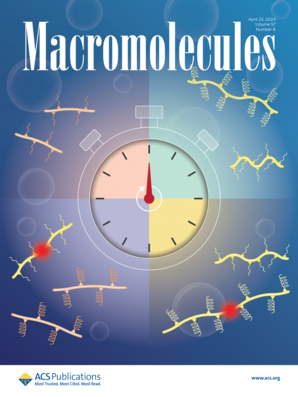一个简单的双字母模型能预测嵌段无规共聚物的复杂溶液相行为吗?
IF 5.1
1区 化学
Q1 POLYMER SCIENCE
引用次数: 0
摘要
合成聚合物的固相行为控制是软材料工程的关键。苯乙烯-异戊二烯嵌段无规共聚物[Taylor, L. W.高分子,2024,57,916-925]的实验揭示了不同序列依赖的相行为结果。这项工作的目的是提供这些实验结果的定量描述,使用一个简单的双字母晶格模型与大规范蒙特卡罗模拟。结果表明,使用单一的溶剂选择参数和适当的温度标化可以实现这一目标。对临界温度、相图和胶束半径的预测与实验结果吻合较好。然而,该模型不能再现大的实验平切胶束,而是预测大的空心核聚集体分解成更小的胶束,这就提出了关于大的实验胶束的平衡性质的问题。该模型定量描述相和聚集行为的能力在这项工作中得到了证明,这对于设计具有理想性能的合成聚合物是有价值的。本文章由计算机程序翻译,如有差异,请以英文原文为准。

Can a Simple Two-Letter Model Predict Complex Solution Phase Behavior of Block–Random Copolymers?
Control of synthetic polymer solution phase behavior is crucial for soft materials engineering. Recent experiments on styrene-isoprene block–random copolymers [Taylor, L. W. Macromolecules 2024, 57, 916–925] revealed various sequence-dependent phase behavior outcomes. This work aims to provide a quantitative description of those experimental findings using a simple two-letter lattice model with grand canonical Monte Carlo simulations. The results demonstrate that this can be achieved using a single solvent selectivity parameter and appropriate temperature scaling. Predictions of critical temperatures, phase diagrams, and certain micelle radii agree well with the corresponding experimental results. However, the model cannot reproduce large experimental crew-cut micelles, instead predicting large hollow-cored aggregates that disassemble into smaller micelles, raising questions about the equilibrium nature of the remarkably large experimental micelles. The model’s ability to quantitatively describe phase and aggregation behavior demonstrated in this work would be valuable for designing synthetic polymers with desirable properties.
求助全文
通过发布文献求助,成功后即可免费获取论文全文。
去求助
来源期刊

Macromolecules
工程技术-高分子科学
CiteScore
9.30
自引率
16.40%
发文量
942
审稿时长
2 months
期刊介绍:
Macromolecules publishes original, fundamental, and impactful research on all aspects of polymer science. Topics of interest include synthesis (e.g., controlled polymerizations, polymerization catalysis, post polymerization modification, new monomer structures and polymer architectures, and polymerization mechanisms/kinetics analysis); phase behavior, thermodynamics, dynamic, and ordering/disordering phenomena (e.g., self-assembly, gelation, crystallization, solution/melt/solid-state characteristics); structure and properties (e.g., mechanical and rheological properties, surface/interfacial characteristics, electronic and transport properties); new state of the art characterization (e.g., spectroscopy, scattering, microscopy, rheology), simulation (e.g., Monte Carlo, molecular dynamics, multi-scale/coarse-grained modeling), and theoretical methods. Renewable/sustainable polymers, polymer networks, responsive polymers, electro-, magneto- and opto-active macromolecules, inorganic polymers, charge-transporting polymers (ion-containing, semiconducting, and conducting), nanostructured polymers, and polymer composites are also of interest. Typical papers published in Macromolecules showcase important and innovative concepts, experimental methods/observations, and theoretical/computational approaches that demonstrate a fundamental advance in the understanding of polymers.
 求助内容:
求助内容: 应助结果提醒方式:
应助结果提醒方式:


